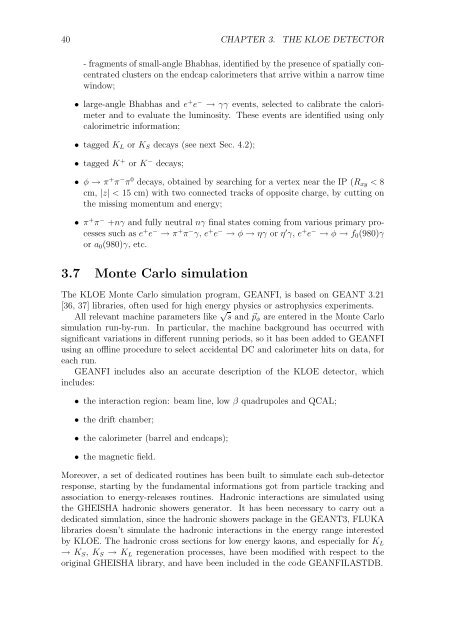Universit`a degli studi Roma Tre Measurement of the KL meson ...
Universit`a degli studi Roma Tre Measurement of the KL meson ...
Universit`a degli studi Roma Tre Measurement of the KL meson ...
Create successful ePaper yourself
Turn your PDF publications into a flip-book with our unique Google optimized e-Paper software.
40 CHAPTER 3. THE <strong>KL</strong>OE DETECTOR<br />
- fragments <strong>of</strong> small-angle Bhabhas, identified by <strong>the</strong> presence <strong>of</strong> spatially concentrated<br />
clusters on <strong>the</strong> endcap calorimeters that arrive within a narrow time<br />
window;<br />
• large-angle Bhabhas and e + e − → γγ events, selected to calibrate <strong>the</strong> calorimeter<br />
and to evaluate <strong>the</strong> luminosity. These events are identified using only<br />
calorimetric information;<br />
• tagged <strong>KL</strong> or KS decays (see next Sec. 4.2);<br />
• tagged K + or K − decays;<br />
• φ → π + π − π 0 decays, obtained by searching for a vertex near <strong>the</strong> IP (Rxy < 8<br />
cm, |z| < 15 cm) with two connected tracks <strong>of</strong> opposite charge, by cutting on<br />
<strong>the</strong> missing momentum and energy;<br />
• π + π − +nγ and fully neutral nγ final states coming from various primary processes<br />
such as e + e − → π + π − γ, e + e − → φ → ηγ or η ′ γ, e + e − → φ → f0(980)γ<br />
or a0(980)γ, etc.<br />
3.7 Monte Carlo simulation<br />
The <strong>KL</strong>OE Monte Carlo simulation program, GEANFI, is based on GEANT 3.21<br />
[36, 37] libraries, <strong>of</strong>ten used for high energy physics or astrophysics experiments.<br />
All relevant machine parameters like √ s and pφ are entered in <strong>the</strong> Monte Carlo<br />
simulation run-by-run. In particular, <strong>the</strong> machine background has occurred with<br />
significant variations in different running periods, so it has been added to GEANFI<br />
using an <strong>of</strong>fline procedure to select accidental DC and calorimeter hits on data, for<br />
each run.<br />
GEANFI includes also an accurate description <strong>of</strong> <strong>the</strong> <strong>KL</strong>OE detector, which<br />
includes:<br />
• <strong>the</strong> interaction region: beam line, low β quadrupoles and QCAL;<br />
• <strong>the</strong> drift chamber;<br />
• <strong>the</strong> calorimeter (barrel and endcaps);<br />
• <strong>the</strong> magnetic field.<br />
Moreover, a set <strong>of</strong> dedicated routines has been built to simulate each sub-detector<br />
response, starting by <strong>the</strong> fundamental informations got from particle tracking and<br />
association to energy-releases routines. Hadronic interactions are simulated using<br />
<strong>the</strong> GHEISHA hadronic showers generator. It has been necessary to carry out a<br />
dedicated simulation, since <strong>the</strong> hadronic showers package in <strong>the</strong> GEANT3, FLUKA<br />
libraries doesn’t simulate <strong>the</strong> hadronic interactions in <strong>the</strong> energy range interested<br />
by <strong>KL</strong>OE. The hadronic cross sections for low energy kaons, and especially for <strong>KL</strong><br />
→ KS, KS → <strong>KL</strong> regeneration processes, have been modified with respect to <strong>the</strong><br />
original GHEISHA library, and have been included in <strong>the</strong> code GEANFILASTDB.
















